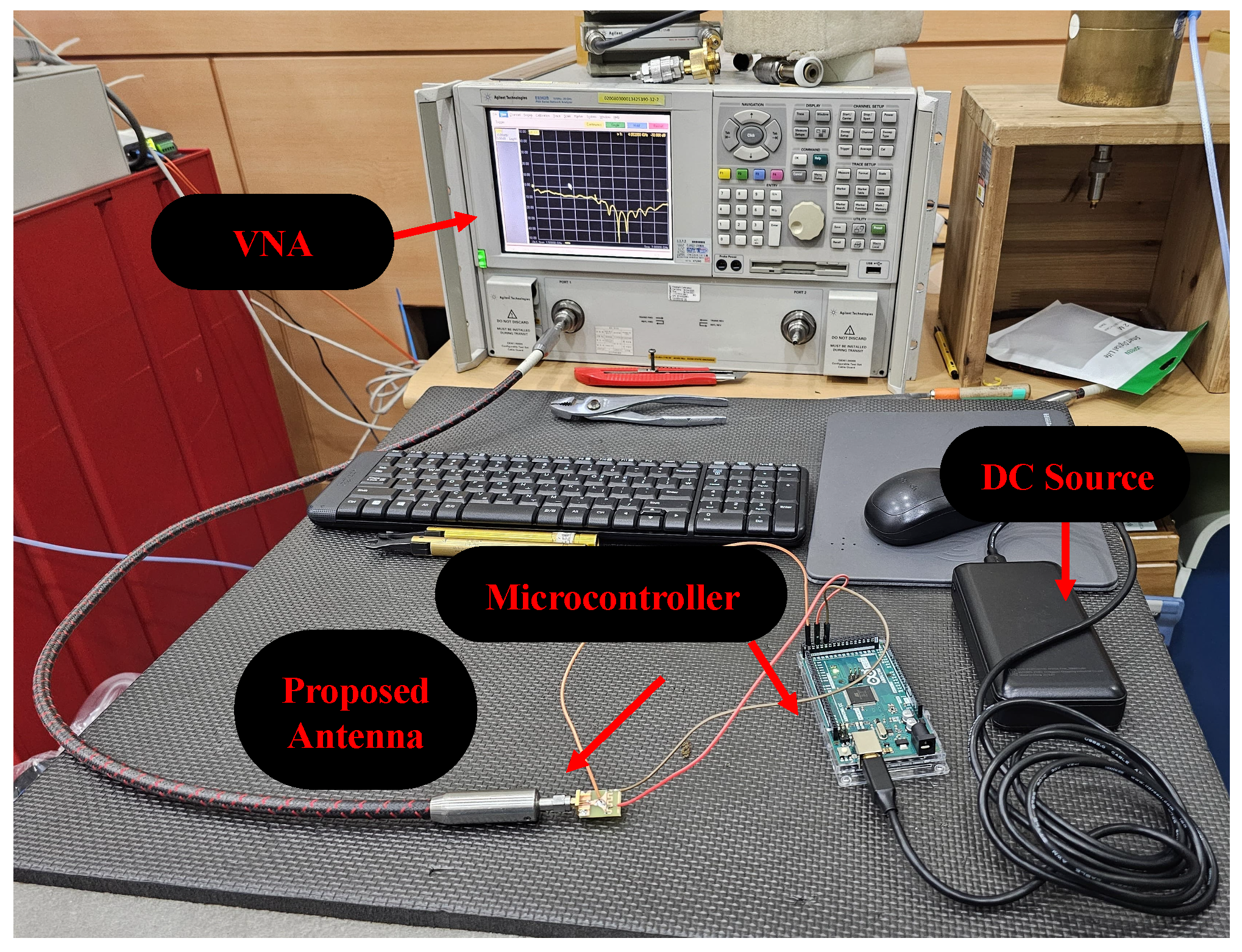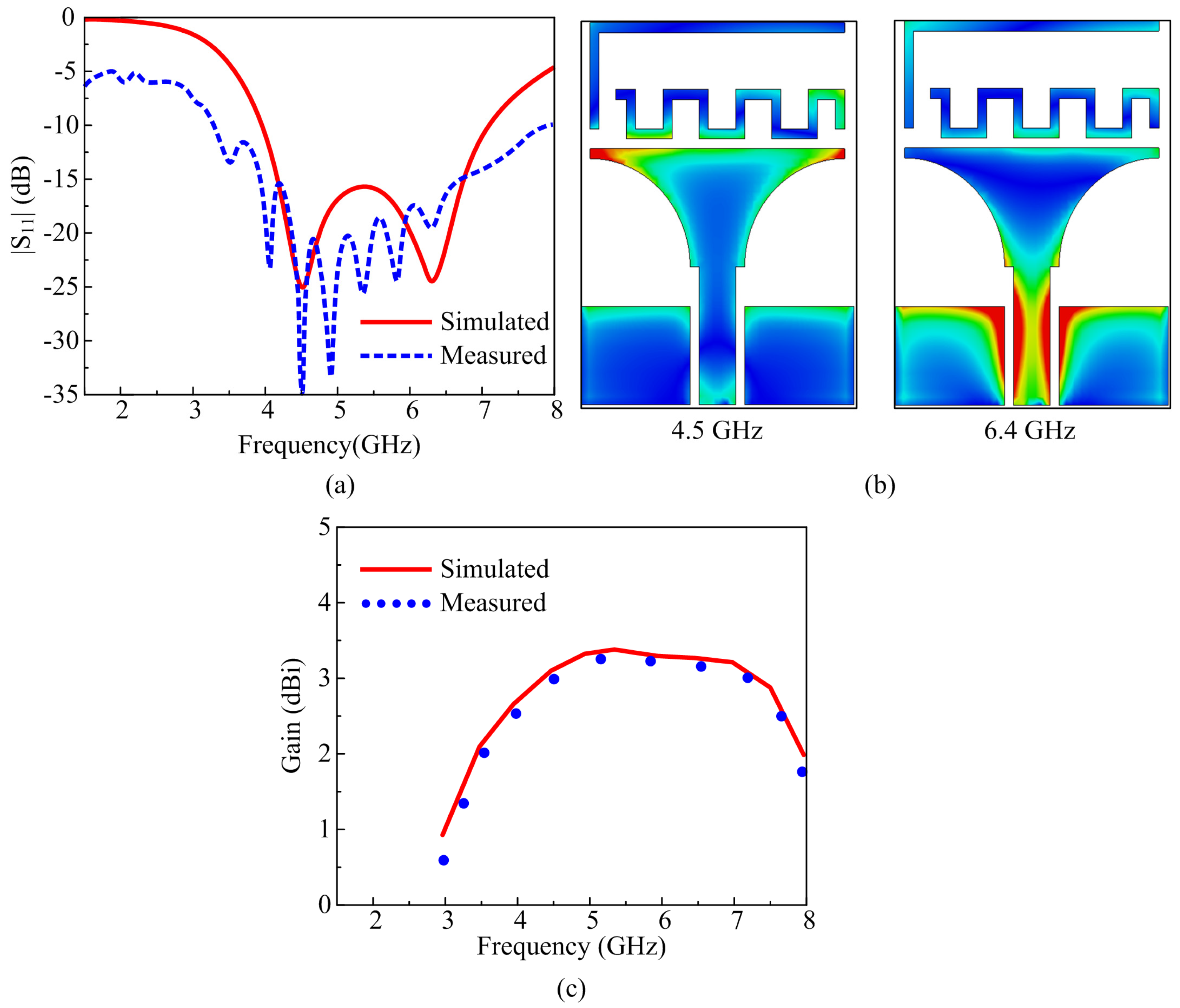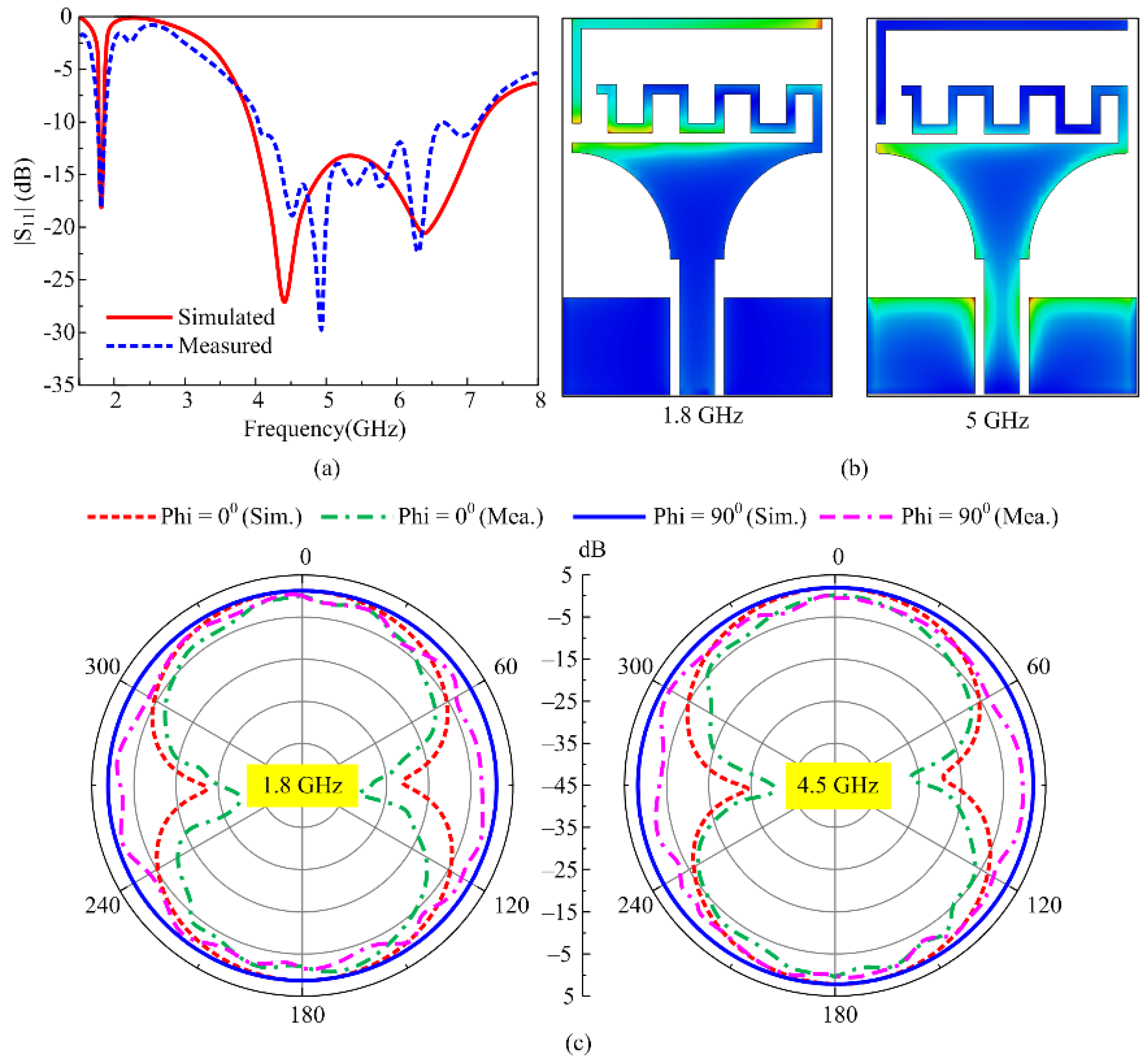Compact Frequency-Agile and Mode-Reconfigurable Antenna for C-Band, Sub-6-GHz-5G, and ISM Applications
Abstract
1. Introduction
2. Antenna Configuration and Design Strategy
2.1. Antenna Design
2.2. Systematic Design Process
2.2.1. Multiband Antenna
2.2.2. Multi-Mode Reconfigurable Antenna
3. Antenna Testing and Result Analysis
3.1. Fabricated Prototype and Measurement Setup
- (1)
- a high-performance portable network analyzer (PNA) by KEYSIGHT with the model number E8362B, with an operational frequency range of 10 MHz to 20 GHz.
- (2)
- a proposed reconfigurable antenna along with soldered diodes, wires, and SMA connector.
- (3)
- a microcontroller utilized to trigger the state of the diodes; an interval of 2 min is given to measure all of the switching states.
- (4)
- A DC source that gives power to the microcontroller, which further provide controlled power to the diodes.
3.2. Mode 1 (Both D1 and D2 Are Off)
3.3. Mode 2 (D1 Is Off While D2 Is On)
3.4. Mode 3 (D1 Is On While D2 Is Off)
3.5. Mode 4 (Both D1 and D2 Are On)
3.6. Comparison with State-of-the-Art Technology
4. Conclusions
Author Contributions
Funding
Data Availability Statement
Conflicts of Interest
References
- Souri, A.; Hussien, A.; Hoseyninezhad, M.; Norouzi, M. A systematic review of IoT communication strategies for an efficient smart environment. Trans. Emerg. Telecommun. Technol. 2022, 33, e3736. [Google Scholar] [CrossRef]
- Zhao, Z.; Chen, X.; Meng, F.; Yang, Z.; Liu, B.; Zhu, N.; Yeo, K.S. Design and Analysis of a 22.6-to-73.9 GHz Low-Noise Amplifier for 5G NR FR2 and NR-U Multiband/Multistandard Communications. IEEE J. Solid-State Circuits 2025, 1–13. [Google Scholar] [CrossRef]
- Amsaveni, A.; Harish, L.; Rashmi, S.; Kaiser, A. Performance analysis of pentagonal MIMO antenna with elliptical slots for 5G V2V communication. Int. J. Veh. Inf. Commun. Syst. 2024, 9, 103–113. [Google Scholar] [CrossRef]
- Khanh, Q.V.; Hoai, N.V.; Manh, L.D.; Le, A.N.; Jeon, G. Wireless communication technologies for IoT in 5G: Vision, applications, and challenges. Wirel. Commun. Mob. Comput. 2022, 2022, 3229294. [Google Scholar] [CrossRef]
- Majid, M.; Habib, S.; Javed, A.R.; Rizwan, M.; Srivastava, G.; Gadekallu, T.R.; Lin, J.C.-W. Applications of wireless sensor networks and internet of things frameworks in the industry revolution 4.0: A systematic literature review. Sensors 2022, 22, 2087. [Google Scholar] [CrossRef]
- Yao, Y.; Shu, F.; Cheng, X.; Liu, H.; Miao, P.; Wu, L. Automotive Radar Optimization Design in a Spectrally Crowded V2I Communication Environment. IEEE Trans. Intell. Transp. Syst. 2023, 24, 8253–8263. [Google Scholar] [CrossRef]
- Luo, H.; Sun, G.; Chi, C.; Yu, H.; Guizani, M. Convergence of Symbiotic Communications and Blockchain for Sustainable and Trustworthy 6G Wireless Networks. IEEE Wirel. Commun. 2025, 32, 18–25. [Google Scholar] [CrossRef]
- Hongyun, C.; Mengyao, Y.; Xue, P.; Ge, X. Joint Active and Passive Beamforming Design for Hybrid RIS-Aided Integrated Sensing and Communication. China Commun. 2024, 21, 1–12. [Google Scholar] [CrossRef]
- Sun, J.; Zhou, S.; Lin, Q. A High-Precision and Fast Modeling Method for Amplifiers. Int. J. Numer. Model. Electron. Netw. Devices Fields. 2025, 38, e70051. [Google Scholar] [CrossRef]
- Prakash, C.; Singh, L.P.; Gupta, A.; Lohan, S.K. Advancements in smart farming: A comprehensive review of IoT, wireless communication, sensors, and hardware for agricultural automation. Sens. Actuators A Phys. 2023, 362, 114605. [Google Scholar] [CrossRef]
- Lee, Y.C.; Ramiah, H.; Choo, A.; Churchill, K.K.P.; Lai, N.S.; Lim, C.C.; Chen, Y.; Mak, P.-I.; Martins, R.P. High-performance multiband ambient RF energy harvesting front-end system for sustainable IoT applications—A review. IEEE Access 2023, 11, 11143–11164. [Google Scholar] [CrossRef]
- Zhang, X.; Zhang, H.; Liu, L.; Han, Z.; Poor, H.V.; Di, B. Target Detection and Positioning Aided by Reconfigurable Surfaces: Reflective or Holographic? IEEE Trans. Wirel. Commun. 2024, 23, 19215–19230. [Google Scholar] [CrossRef]
- Chu, H.; Pan, X.; Jiang, J.; Li, X.; Zheng, L. Adaptive and Robust Channel Estimation for IRS-Aided Millimeter-Wave Communications. IEEE Trans. Veh. Technol. 2024, 73, 9411–9423. [Google Scholar] [CrossRef]
- Wang, C.; Zhang, J.; Bai, S.; Chang, D.; Duan, L. A multiband compact flexible energy collector for wearable or portable IoT devices. IEEE Antennas Wirel. Propag. Lett. 2023, 22, 1164–1168. [Google Scholar] [CrossRef]
- Anagnostou, D.E.; Chryssomallis, M.T.; Goudos, S. Reconfigurable antennas. Electronics 2021, 10, 897. [Google Scholar] [CrossRef]
- Musa, U.; Shah, S.M.; Majid, H.A.; Abidin, Z.Z.; Yahya, M.S.; Babani, S.; Yunusa, Z. Recent advancement of wearable reconfigurable antenna technologies: A review. IEEE Access 2022, 10, 121831–121863. [Google Scholar] [CrossRef]
- Ramahatla, K.; Mosalaosi, M.; Yahya, A.; Basutli, B. Multiband reconfigurable antennas for 5G wireless and CubeSat applications: A review. IEEE Access 2022, 10, 40910–40931. [Google Scholar] [CrossRef]
- Arnaoutoglou, D.G.; Empliouk, T.M.; Kaifas, T.N.F.; Chryssomallis, M.T.; Kyriacou, G. A Review of Multifunctional Antenna Designs for Internet of Things. Electronics 2024, 13, 3200. [Google Scholar] [CrossRef]
- Huang, X.; Zhang, X.; Zhou, L.; Xu, J.; Mao, J. Low-Loss Self-Packaged Ka-Band LTCC Filter Using Artificial Multimode SIW Resonator. IEEE Trans. Circuits Syst. II Express Briefs 2023, 70, 451–455. [Google Scholar] [CrossRef]
- Huang, X.; Zhou, L.; Xu, J.; Zhang, X.Y.; Mao, J. BCB-Based Thin-Film Ka-Band Quarter-Mode SIW Packaged Filters With Ultrawide Stopband and Independently Controlled TZs. IEEE Trans. Microw. Theory Tech. 2022, 70, 4389–4398. [Google Scholar] [CrossRef]
- Qin, J.; Fu, X.; Sun, M.; Ren, Q.; Chen, A. Frequency reconfigurable antenna based on substrate integrated waveguide for S-band and C-band applications. IEEE Access 2020, 9, 2839–2845. [Google Scholar] [CrossRef]
- Ahmad, I.; Dildar, H.; Khan, W.U.R.; Ullah, S.; Ullah, S.; Albreem, M.A.; Alsharif, M.H.; Uthansakul, P. Frequency reconfigurable antenna for multi standard wireless and mobile communication systems. Comput. Mater. Contin. 2021, 68, 2563–2578. [Google Scholar] [CrossRef]
- Gençoğlan, D.N.; Çolak, Ş.; Palandöken, M. Spiral-resonator-based frequency reconfigurable antenna design for sub-6 GHz applications. Appl. Sci. 2023, 13, 8719. [Google Scholar] [CrossRef]
- Bai, Y.; Gardner, P.; He, Y.; Sun, H. A surrogate modeling approach for frequency-reconfigurable antennas. IEEE Trans. Antennas Propag. 2023, 71, 5498–5503. [Google Scholar] [CrossRef]
- Ojaroudi Parchin, N.; Basherlou, H.J.; Al-Yasir, Y.I.A.; Abdulkhaleq, A.M.; Abd-Alhameed, R.A. Reconfigurable antennas: Switching techniques—A survey. Electronics 2020, 9, 336. [Google Scholar] [CrossRef]
- Dildar, H.; Althobiani, F.; Ahmad, I.; Khan, W.U.R.; Ullah, S.; Mufti, N.; Ullah, S.; Muhammad, F.; Irfan, M.; Glowacz, A. Design and experimental analysis of multiband frequency reconfigurable antenna for 5G and sub-6 GHz wireless communication. Micromachines 2020, 12, 32. [Google Scholar] [CrossRef]
- Tang, S.-C.; Wang, X.-Y.; Chen, J.-X. Low-profile frequency-reconfigurable dielectric patch antenna and array based on new varactor-loading scheme. IEEE Trans. Antennas Propag. 2021, 69, 5469–5478. [Google Scholar] [CrossRef]
- Cildir, A.; Gozel, M.A. Compact frequency-reconfigurable circular patch antenna with varactor diode: Design, tuning, and compactness optimization. Microw. Opt. Technol. Lett. 2024, 66, e34341. [Google Scholar] [CrossRef]
- Al-Hadeethi, S.T.; Elwi, T.A.; Ibrahim, A.A. A printed reconfigurable monopole antenna based on a novel metamaterial structures for 5G applications. Micromachines 2023, 14, 131. [Google Scholar] [CrossRef]
- Saraswat, R.K.; Kumar, M. Implementation of the metamaterial multiband frequency reconfigurable antenna for IoT wireless standards. IETE J. Res. 2024, 70, 4594–4605. [Google Scholar] [CrossRef]
- Mathur, P.; Madanan, G.; Raman, S. Mechanically frequency reconfigurable antenna for WSN, WLAN, and LTE 2500 based Internet of Things applications. Int. J. RF Microw. Comput.-Aided Eng. 2021, 31, e22318. [Google Scholar] [CrossRef]
- Ghaffar, A.; Altaf, A.; Aneja, A.; Li, X.J.; Khan, S.; Alibakhshikenari, M.; Flalcone, F.; Limiti, E. A frequency reconfigurable compact planar inverted-F antenna for portable devices. Int. J. Antennas Propag. 2022, 2022, 7239608. [Google Scholar] [CrossRef]
- Kumar, R.V.; Vanitha, M.; Prabu, R.T.; Bindhu, M. Multiband miniaturised frequency reconfigurable patch antenna using PIN diodes. Wirel. Netw. 2022, 28, 2485–2497. [Google Scholar] [CrossRef]
- Karthiga, B.; Mahendran, C. A compact dual-band frequency reconfigurable antenna with PIN diode integration for smartwatch application. Int. J. Electron. Lett. 2024, 2024, 403–412. [Google Scholar] [CrossRef]
- Subbaraj, S.; Kanagasabai, M.; Alsath, M.G.N.; Palaniswamy, S.K.; Kingsly, S.; Kulandhaisamy, I.; Meiyalagan, S. A compact frequency-reconfigurable antenna with independent tuning for hand-held wireless devices. IEEE Trans. Antennas Propag. 2020, 68, 1151–1154. [Google Scholar] [CrossRef]
- Ali, E.M.; Awan, W.A.; Alzaidi, M.S.; Alzahrani, A.; Elkamchouchi, D.H.; Falcone, F.; Ghoneim, S.S.M. A Shorted Stub Loaded UWB Flexible Antenna for Small IoT Devices. Sensors 2023, 23, 748. [Google Scholar] [CrossRef]










| Ref. | Dimensions (mm × mm) | Reconfigurable Modes | Bandwidth (GHz) | No. of Switches |
|---|---|---|---|---|
| [14] | 53.5 × 53.5 | Single Band | 2.4–2.42|5.68–6 | 12 |
| [15] | 30 × 20 | Wideband | 3.51–8.51 | 3 |
| Single Band | 3.10–4.11 | |||
| Dual Band | 2.41–2.81|5.47–7.18 | |||
| Tri-Band | 2.03–2.27|4.61–5.35|5.87–7.22 | |||
| [16] | 16 × 22 | Single Band | 5.15–5.27 | 2 |
| Tri-Band | 2.14–2.17|4.02–4.47|5.15–5.53 | |||
| 2.08–2.11|3.13–3.2|4.49–5.2 | ||||
| [21] | 24 × 51 | Single Band | 0.85–1.3 * | 1 ** |
| [22] | 34 × 34 | Penta-Band | 1.8|3.3|4.8|5.5|5.8 + | 4 |
| Hexa-Band | 1.3|2.1|2.8|3.9|4.8|5.8 + | |||
| Tri-Band | 2.5|3.9|4.8 + | |||
| [23] | 22 × 32 | Octa-Band | 2.34–2.82|3.84–4.53|5.61–5.985|10.46–12.84|13.84–14.50|15.69–17.37|18.21–19.86 | 1 |
| Penta-Band | 3.84–4.53|5.61–5.985|7.89–8.79|13.84–14.50|15.69–17.37 | |||
| [25] | 120 × 60 | Single Band | 0.96|2.1|2.12 + | 2 |
| [28] | 10 × 25 | Single Band | 0.698–0.96|1.6–2.6|3.4–3.8|5–6 * | 4 |
| Proposed | 15 × 20 | Wideband | 3.9–7.15 | 2 |
| Dual Band | 1.78–1.84|3.91–7.23 | |||
| Tri-Band | 2.1– 2.19|2.54–2.65|4.2–7.2 | |||
| 2.55–2.72|3.5–3.85|4.99–7.15 |
Disclaimer/Publisher’s Note: The statements, opinions and data contained in all publications are solely those of the individual author(s) and contributor(s) and not of MDPI and/or the editor(s). MDPI and/or the editor(s) disclaim responsibility for any injury to people or property resulting from any ideas, methods, instructions or products referred to in the content. |
© 2025 by the authors. Licensee MDPI, Basel, Switzerland. This article is an open access article distributed under the terms and conditions of the Creative Commons Attribution (CC BY) license (https://creativecommons.org/licenses/by/4.0/).
Share and Cite
Ali, E.M.; Awan, W.A.; Abbas, A.; Abbas, S.M.; Mohamed, H.G. Compact Frequency-Agile and Mode-Reconfigurable Antenna for C-Band, Sub-6-GHz-5G, and ISM Applications. Micromachines 2025, 16, 724. https://doi.org/10.3390/mi16060724
Ali EM, Awan WA, Abbas A, Abbas SM, Mohamed HG. Compact Frequency-Agile and Mode-Reconfigurable Antenna for C-Band, Sub-6-GHz-5G, and ISM Applications. Micromachines. 2025; 16(6):724. https://doi.org/10.3390/mi16060724
Chicago/Turabian StyleAli, Esraa Mousa, Wahaj Abbas Awan, Anees Abbas, Syed Mujahid Abbas, and Heba G. Mohamed. 2025. "Compact Frequency-Agile and Mode-Reconfigurable Antenna for C-Band, Sub-6-GHz-5G, and ISM Applications" Micromachines 16, no. 6: 724. https://doi.org/10.3390/mi16060724
APA StyleAli, E. M., Awan, W. A., Abbas, A., Abbas, S. M., & Mohamed, H. G. (2025). Compact Frequency-Agile and Mode-Reconfigurable Antenna for C-Band, Sub-6-GHz-5G, and ISM Applications. Micromachines, 16(6), 724. https://doi.org/10.3390/mi16060724











